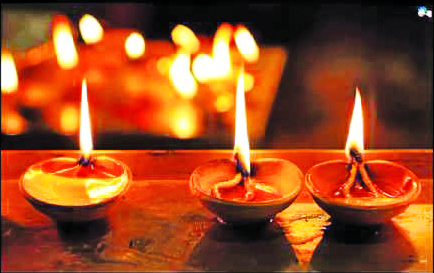Diwali or the festival of lights is associated with Lord Ram’s life – in fact, the return of Ram to Ayodhya. The whole of Ayodhya was lit up with lamps and mashaals to welcome this divine king and his wife, Sita, after 14 years of Vanvaas (exile in a forest). Ever since, Diwali has been celebrated with gay abandon, glitter and glamour, unique to Indians. It also heralds the New Year and is considered an auspicious time for buying a new home or starting a new business. Diwali day is also the New Year’s day for Jains since Lord Mahavir attained Moksh on the dawn of Amavas in the month of Kartik. The Swastika, which is Jainism’s esoteric symbol, signifies the four directions, symbolising that Mahavir’s message applies to all.
Actually, Diwali is celebrated over five days. On the 13th day of Kartik, which is the first celebration, all homes are cleaned, scrubbed, polished and painted in anticipation of the 15th day. This ritual extends to offices and shops too, where sweets are prepared and gold is bought. The second day signifies the killing of the demon ‘Narakasura’ by the Lord. Legend has it that this demon was killed because he imprisoned the daughters, wives, mothers and sisters of all the sages. In North India, this (second) day is known as Roop Chaturdashi.
The third day heralds the welcoming of Lakshmi, the Goddess of wealth. Poojas are held in homes and places of work (offices and factories), where Chopdi-Poojan marks the closing of old books of accounts and starting the new accounts for the new financial year with symbols of Om, Shree or Swastika made with red vermilion (sindoor) on the very first page of the book. Homes and offices are well-lighted with diyas and bulbs. The floors are decorated in colourful rangolis and heavy streams of flowers decorate doorways (torans) because Goddess Laxmi roams the Earth on this day (Dhan-Teras) and she is welcomed to ensure financial and material prosperity.
The fourth day is devoted to building mounds–they could be mounds of grain, mithais or even plain sugar. These mounds represent the Govardhan mountain in Mathura’s district of Braj which was lighted by Lord Krishna to make a safe shelter for the cowherds and their cattle during the great deluge (compare this to Noah’s Arc) sent by an angry Lord Indra. In our very own state of Maharashtra, this day signifies the visit of King Mahabali to Earth. Mahabali was the powerful king who terrorized all others, who requested Lord Vishnu to teach him a lesson. Lord Vishnu manifested in his dwarf form (Vaaman-Avtaar), begging Mahabali for a mere two strides of land. When Mahabali conceded, Vishnu manifested his giant form, covering the entire Earth with two steps. He also banished Mahabali underground (Pataal) right to the centre of the Earth from where Mahabali cried out that he should be allowed to see the surface of the Earth at least one day in a year. Hence, the 16th day of Kartik is a celebration of Mahabali’s annual visit.
The fifth or the last day marks the end of Diwali with Bhai-Dooj, when sisters invite their brothers home for a meal prepared by them in exchange of gifts. This custom has its origin in the legend of Yama, the Lord of Death, who granted his sister Yamuna (the river) a wish that any person bringing gifts to his sister and receiving a tilak on his forehead from her, will defy death, which is what the legend says. Therefore, on this day, brothers and sisters take a dip in the holy waters of Yamuna.
In today’s mad-mad, rush- rush, go-go, materialistic world, who pauses to think of Diwali’s real significance which is to light up someone else’s life with kindness, charity and compassion? To most, Diwali means burning hard-earned money in fire-crackers, with total disregard for old and sick people, noise and pollution. In some fraternities, it also means gambling hard-earned money in lakhs, shopping like mad and going-overboard while buying gold. Today’s Diwali, to some extent is a manifestation of today’s society with all its excesses. The real essence of Diwali, the festival of lights is to spread the light of love, knowledge, duty, compassion and good-will towards every sentient being. It means yielding your heart and mind to God through that light because light is a perfect symbol of that beautiful heavenly spark within our soul (atma) which is the microcosm of God.
So starting with this Diwali, remember to light up someone’s life before you place the diya on your doorstep.
- How Long Can You Stare At Your Wife? - 25 January2025
- Journey To The Inner World - 11 January2025
- Meherbai’s Mandli Hold Last Party Of The Year! - 28 December2024
